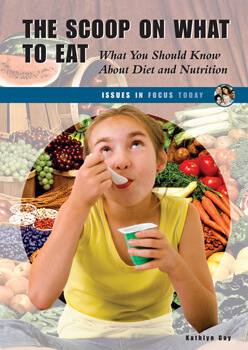
The Scoop on What to Eat
Today's news is constantly filled with stories about obesity and eating disorders, while advertisements give us a confusing message about the best things to eat. Kathlyn Gay explains why young people need to know about nutrition and about how they can make good choices about food. She explores diets, pills and supplements, vegetarian eating, the food pyramid, and more.
* Reviews *
This is a great book for teens to read. It packs a lot of important information into a relatively short amount of space. The book opens with a brief overview of the role food plays in our lives and the fact that it is often the most important feature of socializing. There is an easily understood explanation of Body Mass Index and why it is important to pay attention to what we ingest. This book defines junk food (food that provides little nutrient value and excess calories, fat, salt), fast food (explaining that it is difficult to eat well at fast food restaurants but there are options for those who want to make smart choices), and smart food (those that help the body function in a healthy manner). There are definitions of proteins, carbohydrates, fats (the various kinds), calories, vitamins, and minerals. This book explores the various reasons for eating and why people eat when they are not even hungry. There is great information about how media ads influence body image, eating poorly, and suggesting fad diets and diet pills. There are references to studies on obesity in America and projected trends if people continue bad eating habits. A chapter about eating disorders discuses symptoms and effects of anorexia and bulimia. In the Healthy Eating chapter, the updated food pyramid is listed along with information from the U.S. Department of Health and Human Services Dietary Guidelines for Americans. I am impressed and happy to see that this chapter also mentions Eat, Drink, and Be Healthy and Harvards Healthy Eating pyramid which contradicts some of the USDA recommendations. This provides a nice balance of information and the knowledge that there are multiple perspectives and that research can provide a vast amount of pertinent information. The final few chapters offer information about alternative eating choices such as vegetarianism as well as providing healthy eating options. There is also a chapter dedicated to the importance of physical activity, which they call the partner to nutrition in a healthy eating plan. Every teen should read this book not only for the factual food information but also for the look at social behavior and media and peer influence., Children's Literature










